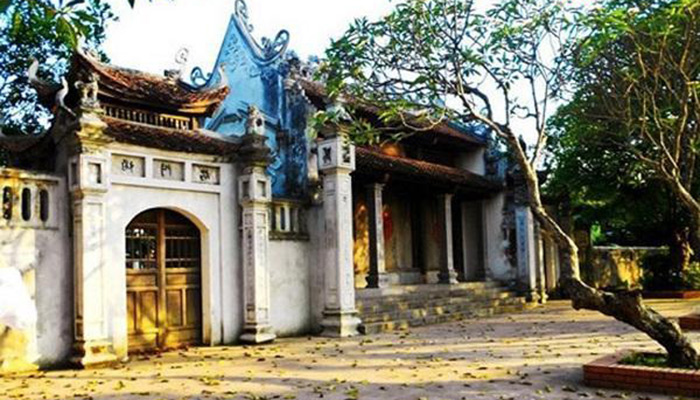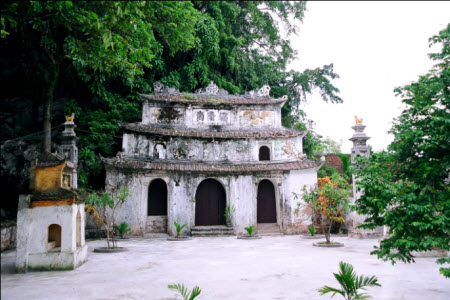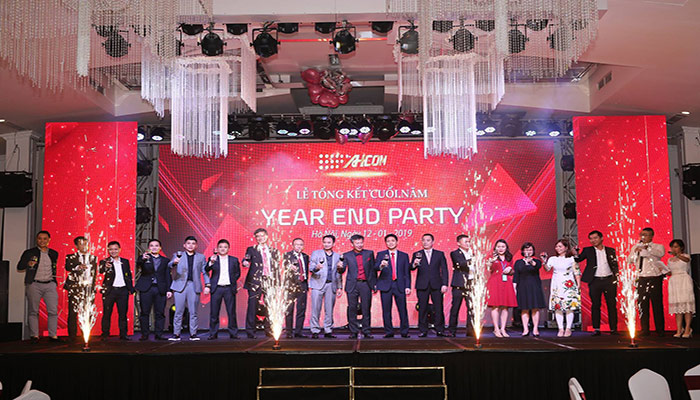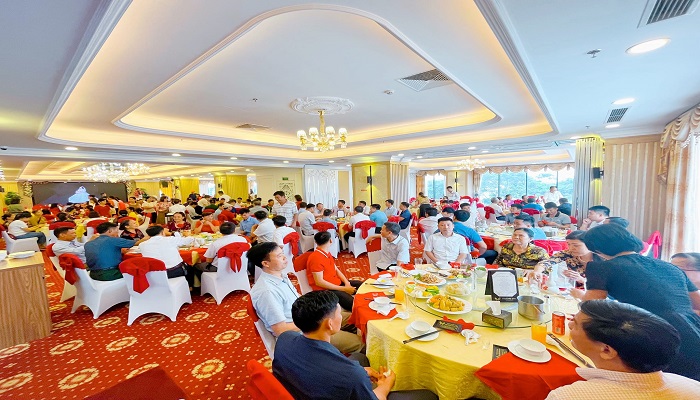Exploring Chau Temple and Pagoda
Chau Temple and Pagoda is a well-known spiritual tourist destination located in Kien Khe town, Thanh Liem district, Ha Nam province. This is the place where Thanh Hoang village and the Temple dedicated to General Pham Ngu Lao, a prominent military leader during the Tran Dynasty, are worshiped.

Situated in a spacious area overlooking the Day River, Chau Temple and Pagoda boasts majestic architecture with curved roofs adorned with unique carvings. Chau Village Temple has a large design, measuring 18m in length, 10.7m in width, and constructed from a massive amount of ironwood. The main structure follows a three-section architectural style, with a front hall consisting of 5 bays, a second hall with 5 bays, and a central sanctum with 3 bays. In total, there are 13 bays, and the southern roof is elegantly designed with decorative elements, displaying intricate craftsmanship.
Chau Village Temple also houses many valuable artistic artifacts, showcasing the unique traditional lacquer art of the ethnic people. Notable items include two ceremonial platforms from the Later Le period in the central sanctum, a ceremonial tray featuring Nguyen Dynasty artistry, a set of eight ritual dishes, a ceremonial sedan chair, and various other valuable religious artifacts.
Chau Pagoda, also known as Chau Son Tu (Pagoda on Chau Mountain) or Long Son Tu (Dragon Mountain Pagoda), is located deep within the rock face, adjacent to the entrance of Phuc Long Cave on Chau Mountain. The pagoda, believed to be ancient, is nestled into the rock face with a stone roof, leading people to believe it lies within the mouth of a dragon. According to the 11th Chinh Hoa Stele (1690), which is carved directly into the rock face, it records the virtuous deeds of a French Zen master and the villagers who, over four generations, contributed to the repair of Buddhist statues and the restructuring of the temple's three treasures of land. This indicates that the pagoda was built quite early, primarily relying on the natural landscape. Today, the pagoda consists of three buildings, following a front - back, nail - shaped structure, with a total of 10 interconnected bays. The bell tower, with three bays, is located on the outermost side, designed with a curved roof, tube tiles, copper pillars, and eaves in traditional style.

The pagoda faces south, with three western bays adjacent to the Pham Ngu Lao shrine and five eastern bays for ancestral worship. Following these are the study hall, guesthouse, and kitchen. In front, there are two separate buildings dedicated to worshiping Lady Thuy Tinh and Princess Bach Hoa, each with five bays. Thus, the entire temple complex consists of 30 interconnected bays of various sizes. In front of the pagoda, there is a pond and a spacious courtyard, followed by the main path leading to the gate. Within the temple grounds, there are numerous perennial trees combined with grass, creating a tranquil landscape. Chau Pagoda houses several impressive but non - authentic statues such as the Three Buddhas, Amitabha Buddha, Maitreya Buddha, Snow Mountain Bodhisattva, and Diamond Buddha. Additionally, there are stone worship items like incense holders and offering bowls, meticulously crafted with elaborate designs, showcasing high craftsmanship and diverse creative expressions.
Simultaneously, when visiting Chau Village Temple on Chau Mountain, tourists can explore Phuc Long Cave located within the temple complex.
Chau Mountain is characterized by stacked rock formations, resembling the head of a dragon. Some rocks protrude like dragon horns at the summit, while others stand upright like dragon hair. Towards the south, a rocky roof extends outward, underneath which rock ledges create the appearance of a dragon's mouth, with the temple nestled like a pearl inside. Numerous rock ledges form convenient steps for climbing the mountain and enjoying the panoramic views. At the mountain's peak, various ancient trees offer different shapes, providing a sweeping view of the picturesque landscapes, including the Day River, But Son Mountain, Ho Citadel, Thanh Thuy Forest Mountain, and the Day River itself.
Ascending about 2 meters from ground level to the cave entrance, after approximately 5 meters, there is a junction. Turning right and descending for tens of meters leads to a cave adorned with beautiful stalactites, while turning left leads to a path with rugged rock formations that create peculiar shapes. This is Phuc Long Cave, which resembles a dragon tightening its pouch, and is home to numerous bats clinging to the walls, earning it the local nickname of 'bat cave.' The cave can accommodate several hundred people.
The cave harmoniously blends with the scenic beauty of Chau Mountain, adjacent to Chau Village Temple, creating an attractive natural landmark for visitors from near and far. Therefore, if you have the opportunity to visit Ha Nam, do not miss the chance to explore this fascinating tourist destination.
Furthermore, if you are unsure about choosing accommodation, feel free to contact Tien Loc Palace Hotel at the hotline 02263 82 5555 for the most attentive advice and assistance!

.jpg)








